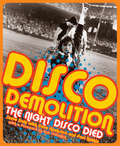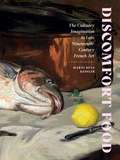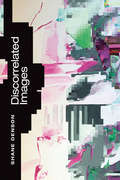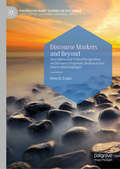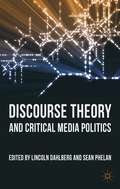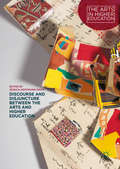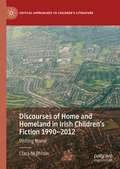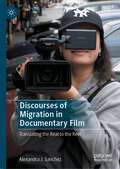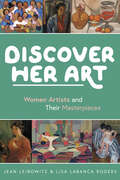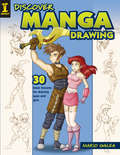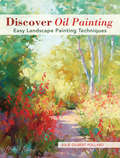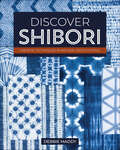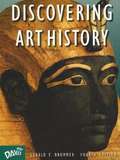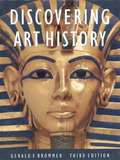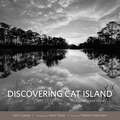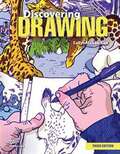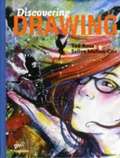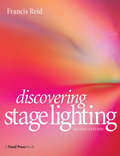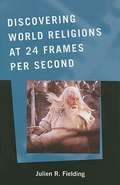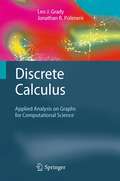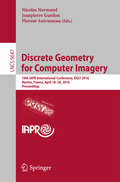- Table View
- List View
Disco Demolition: The Night Disco Died
by Bob Odenkirk Paul Natkin Dave Hoekstra Steve Dahl"If you were young and shiftless--and viscerally repulsed by Abba--Steve Dahl was a god. And you were drawn to Disco Demolition." --ESPN.com.In the late 1970s, disco dominated radio airwaves, much to the dismay of rock music fans. To boost attendance at Comiskey Park, the White Sox and Chicago DJ legend Steve Dahl collaborated to host Disco Demolition on July 12, 1979. Admission to the park was ninety-eight cents and a disco record. Records were destroyed on the field between games, declaring absolutely how rock fans felt about disco.Attendance exceeded fifty thousand, far beyond anyone's estimations, and when fans stormed the field for the demolition, chaos ensued. Police cleared the field, Comiskey Park was evacuated, and the second game was cancelled--for the first time in MLB history. In collaboration with Steve Dahl, Disco Demolition examines the night that changed America's disco culture forever, featuring a foreword by Bob Odenkirk and over thirty interviews with sports and music icons, including Rick Nielsen of Cheap Trick and KC and the Sunshine Band, conducted by journalist Dave Hoekstra. Also featuring a foreword by actor Bob Odenkirk (Better Call Saul, Breaking Bad) and photographs by Paul Natkin.Steve Dahl is an American radio personality and former columnist for the Chicago Tribune.Dave Hoekstra is a former columnist for the Chicago Sun-Times and a longtime radio host for WGN.Paul Natkin has photographed The Rolling Stones, Keith Richards, Brian Wilson, and many others. He was an official photographer of the Oprah Winfrey Show, and has shot magazine covers for Newsweek, Ebony, Spin, and People.
Discomfort Food: The Culinary Imagination in Late Nineteenth-Century French Art
by Marni Reva KesslerAn intricate and provocative journey through nineteenth-century depictions of food and the often uncomfortable feelings they evokeAt a time when chefs are celebrities and beautifully illustrated cookbooks, blogs, and Instagram posts make our mouths water, scholar Marni Reva Kessler trains her inquisitive eye on the depictions of food in nineteenth-century French art. Arguing that disjointed senses of anxiety, nostalgia, and melancholy underlie the superficial abundance in works by Manet, Degas, and others, Kessler shows how, in their images, food presented a spectrum of pleasure and unease associated with modern life.Utilizing close analysis and deep archival research, Kessler discovers the complex narratives behind such beloved works as Manet&’s Fish (Still Life) and Antoine Vollon&’s Internet-famous Mound of Butter. Kessler brings to these works an expansive historical review, creating interpretations rich in nuance and theoretical implications. She also transforms the traditional paradigm for study of images of edible subjects, showing that simple categorization as still life is not sufficient.Discomfort Food marks an important contribution to conversations about a fundamental theme that unites us as humans: food. Suggestive and accessible, it reveals the very personal, often uncomfortable feelings hiding within the relationship between ourselves and the representations of what we eat.
Discorrelated Images
by Shane DensonIn Discorrelated Images Shane Denson examines how computer-generated digital images displace and transform the traditional spatial and temporal relationships that viewers had with conventional analog forms of cinema. Denson analyzes works ranging from the Transformers series and Blade Runner 2049 to videogames and multimedia installations to show how what he calls discorrelated images—images that do not correlate with the abilities and limits of human perception—produce new subjectivities, affects, and potentials for perception and action. Denson's theorization suggests that new media theory and its focus on technological development must now be inseparable from film and cinema theory. There's more at stake in understanding discorrelated images, Denson contends, than just a reshaping of cinema, the development of new technical imaging processes, and the evolution of film and media studies: discorrelated images herald a transformation of subjectivity itself and are essential to our ability to comprehend nonhuman agency.
Discourse Markers and Beyond: Descriptive and Critical Perspectives on Discourse-Pragmatic Devices across Genres and Languages (Postdisciplinary Studies in Discourse)
by Péter B. FurkóThis book explores the use of discourse markers - lexical items where drawing a distinction between propositional and non-propositional, syntactically-semantically integrated and discourse-pragmatic uses is especially relevant. Using a combination of qualitative and quantitative methodologies, descriptive and critical (CDA) perspectives, and manual annotation and automatized analyses, the author argues that Discourse Markers (DMs) cannot be effectively studied in isolation, but must instead be contextualised with reference to other discourse-pragmatic devices and their language and genre backgrounds. This book will be of interest to students and academics working in the fields of DM research and critical discourse studies, and will also appeal to scholars working in areas such as genre studies, second language acquisition (SLA), literary analysis, contemporary cinematography, Tolkien scholarship, and Bible studies.
Discourse Theory and Critical Media Politics
by Lincoln Dahlberg Sean PhelanA systematic examination of the relationship between post-Marxist discourse theory and media studies. This volume interrogates discourse theory - as read via the work of Ernesto Laclau and Chantal Mouffe - through an engagement with major approaches to critical media politics and a range of issues in contemporary media politics.
Discourse and Disjuncture between the Arts and Higher Education
by Jessica Hoffmann Hoffmann DavisThis accessible and compelling collection offaculty reflections examines the tensions between the arts and academics andoffers interdisciplinary alternatives for higher education. With an eye toteacher training, these artist scholars share insights, models, and personalexperience that will engage and inspire educators in a range of post-secondarysettings. The authors represent a variety of art forms, perspectives, andpurposes for arts inclusive learning ranging from studio work to classroomteaching to urban settings in which the subject is equity and social justice. From the struggles of an arts concentrator at an Ivy League college to thechallenge of reconciling the dual identities as artists and arts educators, theissues at hand are candid and compelling. The examples of discourse rangingfrom the broad stage of arts advocacy to an individual course or program givetestimony to the power and promise of the arts in higher education.
Discourses of Home and Homeland in Irish Children’s Fiction 1990-2012: Writing Home (Critical Approaches to Children's Literature)
by Ciara Ní BhroinIn the context of changing constructs of home and of childhood since the mid-twentieth century, this book examines discourses of home and homeland in Irish children’s fiction from 1990 to 2012, a time of dramatic change in Ireland spanning the rise and fall of the Celtic Tiger and of unprecedented growth in Irish children’s literature. Close readings of selected texts by five award-winning authors are linked to social, intellectual and political changes in the period covered and draw on postcolonial, feminist, cultural and children’s literature theory, highlighting the political and ideological dimensions of home and the value of children’s literature as a lens through which to view culture and society as well as an imaginative space where young people can engage with complex ideas relevant to their lives and the world in which they live. Examining the works of O. R. Melling, Kate Thompson, Eoin Colfer, Siobhán Parkinson and Siobhan Dowd, Ciara Ní Bhroin argues that Irish children’s literature changed at this time from being a vehicle that largely promoted hegemonic ideologies of home in post-independence Ireland to a site of resistance to complacent notions of home in Celtic Tiger Ireland.
Discourses of Migration in Documentary Film: Translating the Real to the Reel
by Alexandra J. SanchezThis book proposes a new approach to the study of discourse in documentary film. It considers discourse as a basic factor of translation (as well as contexts, agents, and practices) and draws on the parallels between the disciplines of translating and documentary making to perform a discourse analysis of documentaries centering on migration. By relying on the concept of translation as a heuristic tool, the author highlights the discursive mechanisms of 18 documentaries on Latin American migration shown in the United States by the Public Broadcasting Service series POV between 1996 and 2018. This interdisciplinary approach facilitates a holistic analysis of documentary film discourse, while also raising awareness of positive discourses of migration. The book will be of interest to students and scholars involved in the study of discourse, translation, documentary, television, and migration.
Discover Her Art: Women Artists and Their Masterpieces
by Jean Leibowitz Lisa LaBanca Rogers"Discover Her Art is a brilliant guide to understanding how a painting does what it does." —Emily Eveleth, painterDiscover Her Art invites young art lovers and artists to learn about painting through the lives and masterpieces of 24 women from the 16th to the 20th century. In each chapter, readers arrive at a masterwork, explore it with an artist's eye, and learn about the painter's remarkable life and the inspirations behind her work. Young artists will discover how these 24 amazing women used composition, color, value, shape, and line in paintings that range from highly realistic to fully abstract. Hands-on exercises encourage readers to create their own art!Whether you love to make art or just look at it, you will enjoy discovering the great work of these women artists.
Discover MANGA DRAWING: 30 Basic Lessons for Drawing Guys and Girls
by Mario GaleaLearn to draw your own fun characters in the popular manga style with this kit featuring an instructional booklet, pencils, paper and markers. Easy to follow instructions take characters from basic sketches to full-color finished illustrations.
Discover Oil Painting: Easy Landscape Painting Techniques
by Julie Gilbert PollardYou Can Paint With Oils! An easy and fun introduction to landscape painting.Discover Oil Painting is a complete course on painting landscapes in oils. This fun and easy guide is loaded with time-honored methods, techniques and tutorials along with ways to tweak those ideas to suit your own painting personality. No matter what your experience (or lack of experience!) you will learn how to paint beautiful works of art in no time.21 step-by-step painting demonstrations tackle skies, foliage, wildflowers, water, rocks and moreEasy-to-understand lessons demystify composition, color, value, paint application techniques, and other key conceptsExpert tips and advice honed over nearly 35 years of professional teaching and paintingWith master teacher Julie Gilbert Pollard, you will walk through the painting process in manageable steps, from laying out a palette and overcoming the initial intimidation of a blank canvas, to designing strong compositions and achieving brilliant, yet believable color. Along this path to successful landscapes, you will find the stepping stones to losing yourself in the journey and discovering the pure pleasure in painting with oils and using your own creativity.
Discover Shibori: Creative Techniques in Natural Indigo Dyeing
by Debbie MaddyExplore the captivating world of traditional Shibori techniques. Learn techniques such as shape resist, stitch resist, pole wrapping, pleat, bind, looped binding, and bound resist in this practical guide by expert shibori teacher Debbie Maddy. From selecting and preparing fabrics to setting and maintaining an indigo vat, this book provides a solid foundation for beginners while also delving into sophisticated techniques such as Katano pleating and stitching that will elevate your projects. Apply your newly acquired skills in six inspiring projects to showcase your freshly dyed fabric, including a scarf, a shawl, an apron, a pillow, a table runner, and a quilt. Not just the basics of shibori and indigo dyeing, discover unique techniques to elevate your craft Learn 35 meditative shibori techniques, including wrapping, pleating, folding, slow stitching, and more Master three natural indigo vats and show off your dyed fabrics in six stunning projects, including a pillow, table runner, quilt, apron, scarf, and shawl
Discovering Art History
by Gerald F. BrommerThis new edition of Discovering Art History is an in-depth, comprehensive approach to art. The program includes an extensive survey of Western art, studies of non-Western art, as well as an introduction to art appreciation. Engaging studio activities throughout the text are keyed to chapter content. This premier art history program will show students how the visual arts serve to shape and reflect ideas, issues, and themes from the time of the first cave paintings to the twenty-first century. The Student Book includes:In-depth profiles of artists, artistic periods, and movements Vibrant maps, timelines, and diagrams Student profiles for peer comparison of studio exercises
Discovering Art History (Third Edition)
by Gerald F. BrommerThis student textbook presents the history of art through the ages. It offers a dynamic format and a flexible structure, with maps, timelines and quotations to add historical perspective to art periods. A teacher's resource binder and disk are available separately.
Discovering Art History (Third Edition)
by Gerald F. BrommerThis student textbook presents the history of art through the ages. It offers a dynamic format and a flexible structure, with maps, timelines and quotations to add historical perspective to art periods. A teacher's resource binder and disk are available separately.
Discovering Buried Worlds
by André ParrotIn this classic work, the eminent archeologist recounts his historic excavations and the significant Biblical findings they revealed. French archeologist André Parrot led some of the most important digs of the twentieth century. In 1933, he began excavations on the right bank of the Euphrates River in present-day Syria. Uncovering numerous artifacts and architecture, he was able to identify the site as the Mesopotamian city of Mari. In this wide-ranging work, Parrot vividly chronicles his experiences, and shows how ancient discoveries can connect the biblical world to ours. In accessible and engaging prose, Parrot also discusses the history of archeological excavation and many of the civilizations we have learned about through the practice. He also delves into the ways archeological discovery has helped shed light on the Bible itself.
Discovering Cat Island: Photographs and History
by John CuevasCat Island, just off the Mississippi Gulf Coast shoreline, has been home to some of the most dramatic events and remarkable stories in the nation's history. While some of these stories are fact, others are colorful fables passed down through the ages with such conviction they have become true in the hearts and minds of many. Between fact and fiction is the undeniable reality: Cat Island is one of the most historically significant landmarks on the Mississippi Gulf Coast.Featuring over 160 black-and-white photographs by Jason Taylor and a foreword by Mississippi's Secretary of State Delbert Hosemann, John Cuevas's Discovering Cat Island guides readers through Cat Island with stories and histories of twenty-nine sites--both real and imagined--of the legendary barrier island. Originally owned by the Cuevas family as part of a Spanish land grant to Juan de Cuevas in 1781, Cat Island boasts a colorful history that includes events related to the notorious pirate Jean Lafitte and the outlaw James Copeland, both of whom were thought to have buried their stolen treasure somewhere on the island; the Battle of New Orleans; and the War of 1812. The island served as one of the staging areas for the Seminole forced to abandon their homes and take part in the Trail of Tears. In the twentieth century, the island was a convenient transfer point for gangsters and local bootleggers shipping booze during Prohibition before becoming a US military training camp site during World War II. In 1988, Cat Island became the location of the first oil drilling ever in the Mississippi Sound and in 2010 was one of the islands devastated by the BP Deepwater Horizon oil spill.
Discovering Drawing
by Ted RoseWith this book, students bridge the gap between art instruction, artistic impression, and personal discovery as they explore all facets of the drawing process. Covers: Exercises, tips and captions enhance student understanding; Techniques and sidebars; Artist biographies and high-interest anecdotes personalize art history and the drawing experience; In-depth artist profiles allow students to examine how contemporary artists view their own work and the creative process.
Discovering Drawing (2nd edition)
by Sallye Mahan-Cox Ted RoseWhat Is Drawing?, Elements and Principles of Design, Basics, Still Life, Drawing Landscapes, The Built Environment, Portraits, The Figure, Drawing Animal, The Expressive Language are explained in ten chapters of this book.
Discovering Great Artists: Hands-On Art Experiences in the Styles of Great Masters (Bright Ideas for Learning #Vol. 6)
by Kim Solga MaryAnn F. KohlDiscovering Great Artists is a creative collection of easy art-appreciation activities for children. Kids will find 110 amazingly fun and unique projects to experience the styles and techniques of the great masters from the Renaissance to the present. A brief biography of each artist is included with each fully illustrated, child-tested art activity that introduces the featured painting. Artists include painters, sculptors, photographers and more.
Discovering Stage Lighting
by Francis ReidThis guide to the fundamentals of stage lighting includes a series of projects to allow experimentation, discussion and analysis. The necessary equipment is described in relation to its purpose, along with checklists and hints for practical use. The practical handling of light, with observation of the relationship of cause to effect, is central to the study of stage lighting. Rehearsal pressures usually restrict the time available for experimenting with lighting for a performance, but laboratory-style projects can be used to enable specific lighting problems to be solved.The core of this book is a series of 'discovery' projects using minimal resources, to explore the use of light in the theatre, with particular emphasis on the interaction of conflicting visual aims. The projects cover all the major scenarios likely to be encountered by lighting students and have been tried and tested by the author, who has taught lighting students all over the world for over 30 years. The book has been updated to include more on safety and the latest technology including:- fixed instruments using the new lower wattage high efficiency lamps in combination with dichronic reflectors- an increase in the availability, reliability, range and usage of 'moving light' technology based on remotely controlled instruments.New lighting projects have also been added.If you are studying the art and craft of stage lighting this book is an excellent working manual that will provide you with the technical knowledge and skill to cope with a range of lighting situations.
Discovering World Religions at 24 Frames Per Second
by Julien R. FieldingTraditionally, university students have gained access to world religions by reading primary texts. Discovering World Religions at 24 Frames Per Second takes students beyond the written page, offering an exploration of the same religious traditions through the study of feature films. The many definitions of religion are examined along with its various components, including doctrine, myth, ethics, ritual, and symbol. Specific religious traditions, including Hinduism, Sikhism, Zoroastrianism, Buddhism, Confucianism, Daoism, popular religion, and Shinto are examined. Biographical sketches of directors whose films tend to focus on a particular religious tradition are also included, such as Zhang Yimou, Hayao Miyazaki, Deepa Mehta, and Akira Kurosawa. Discovering World Religions at 24 Frames Per Second is unique in the area of religion and film studies in that it isn't just a collection of essays. Instead it provides the introductory student with the necessary background information on the various religions before looking at how their ideas can be understood not through texts but through the cinematic medium. To keep the conversation fresh, most of the films used in the book were made within the last decade. Furthermore, examples range from popular, mainstream fare, such as Star Wars and the Lord of the Rings trilogy to lesser-known foreign films, such as The Wooden Man's Bride and The Great Yokai War. Several films with a "cult-like" following are also discussed, including Fight Club, Princess Mononoke, Spirited Away, and Jacob's Ladder. This book is also unique in that instead of drawing upon the Judeo-Christian tradition, it draws from Eastern traditions.
Discrete Calculus
by Leo J. Grady Jonathan R. PolimeniThe field of discrete calculus, also known as "discrete exterior calculus", focuses on finding a proper set of definitions and differential operators that make it possible to operate the machinery of multivariate calculus on a finite, discrete space. In contrast to traditional goals of finding an accurate discretization of conventional multivariate calculus, discrete calculus establishes a separate, equivalent calculus that operates purely in the discrete space without any reference to an underlying continuous process. This unique text brings together into a single framework current research in the three areas of discrete calculus, complex networks, and algorithmic content extraction. Although there have been a few intersections in the literature between these disciplines, they have developed largely independently of one another, yet researchers working in any one of these three areas can strongly benefit from the tools and techniques being used in the others. Many example applications from several fields of computational science are provided to demonstrate the usefulness of this framework to a broad range of problems. Readers are assumed to be familiar with the basics of vector calculus, graph theory, and linear algebra. Topics and features: presents a thorough review of discrete calculus, with a focus on key concepts required for successful application; unifies many standard image processing algorithms into a common framework for viewing a wide variety of standard algorithms in filtering, clustering, and manifold learning that may be applied to processing data associated with a graph or network; explains how discrete calculus provides a natural definition of "low-frequency" on a graph, which then yields filtering and denoising algorithms; discusses how filtering algorithms can give rise to clustering algorithms, which can be used to develop manifold learning and data discovery methods; examines ranking algorithms, as well as algorithms for analyzing the structure of a network. Graduate students and researchers interested in discrete calculus, complex networks, image processing and computer graphics will find this text/reference a clear introduction to the foundations of discrete calculus as well as a useful guide to have readily available for their work. Dr. Leo J. Grady is a Senior Research Scientist with Siemens Corporate Research in Princeton, New Jersey, USA. Dr. Jonathan R. Polimeni is a Research Fellow at the Massachusetts General Hospital in Boston, Massachusetts, USA, and Instructor in Radiology at Harvard Medical School, Boston, Massachusetts, USA.
Discrete Geometry for Computer Imagery
by Nicolas Normand Jeanpierre Guédon Florent AutrusseauThisbook constitutes the refereed proceedings of the 19th IAPR InternationalConference on Discrete Geometry for Computer Imagery, DGCI 2016, held in Nantes,France, in April 2016. The 32 revised full papers presented together with 2invited talks were carefully selected from 51 submissions. The papers areorganized in topical sections on combinatorial tools; discretization; discretetomography; discrete and combinatorial topology; shape descriptors; models fordiscrete geometry; circle drawing; morphological analysis; geometrictransforms; and discrete shape representation, recognition and analysis.
